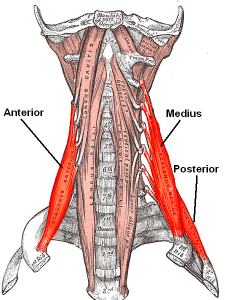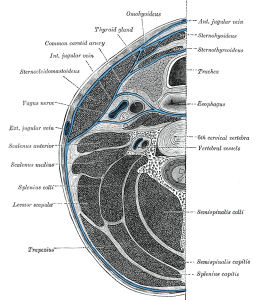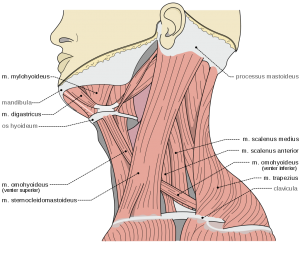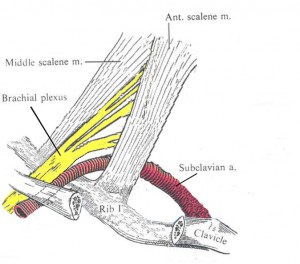 The scalene muscles are three paired muscles of differing lengths.
The scalene muscles are three paired muscles of differing lengths.
They originate from the transverse process of the 2nd-7th cervical vertebrae (the neck), and insert on the first and second ribs.
They are three (sometimes four) muscles that act to flex, bend and rotate the neck depending on how they are working together and what part of the skeleton is fixed or moving.
If the ribcage doesn’t move, all three of the scalene muscles can bend the neck forward and sideways, and rotate it as well.
When the head and neck are held steady, the scalenus anterior and medius both elevate the first rib while the scalenus posterior elevates the second rib to assist in breathing and create more space in the thoracic cavity.
Forward head posture is endemic to our society. If you live and breathe the odds are you suffer from this postural problem. And if you do, the scalene muscles are part of the problem.
Take some pictures of yourself, look in a mirror or try to stand with your back to the wall and get the entire back of your body (other than the lower back and the neck) to the wall. If your head doesn’t get there comfortably you have tight scalene muscles and forward head posture.
I can promise that you are not alone.
Forward head posture creates an imbalance between the muscles of the head neck and shoulders.
The muscles in front of your neck tend to become over-extended while those at the back of the neck usually are short, tight and suffering.
When the scalenes and sternocleidomastoid (SCM) are pulled forward posturally, the erector spinea muscles, meant to elevate the spine are pulled forward as well, and lose their erectile capabilities.
Another part of the head and neck that is affected are the sub occipital muscles connecting the head to the top of the spine.
These are the only muscles in the body with a connection to the spinal cord, and their ability to communicate with the spine is severely compromised by forward head posture and misaligned scalene muscles.
Most pains in the neck involve the scalene muscles to one degree or another.
You can suffer from tight scalenes on one side of the neck as well.
A dysfunctional psoas major (my favorite muscle) often creates a leg length discrepancy which can inhibit or shorten the entire side of the body, including and creating short tight scalenes.
The scalene muscles, along with the SCM are situated in a key spot in our anatomical structure and therefore can be involved with numerous nerve pain related problems.
The nerves need space to flow in order to power the body and tight muscles often mess with the optimal flow of nervous energy.
The most critical aspect of misaligned scalene muscles occurs with the brachial plexus, a network of nerves that emanate from the spine, passing through the neck, on the way to innervate the arm.
The brachial plexus’ route from the spine to the arm passes directly between scalenus anterior and scalenus medius. Short, tight or generally misaligned scalene muscles can impact the brachial plexus directly.
The list of problems that can be related to the brachial plexus is fairly long and while the scalene muscles might not be the exact cause they will always be related to head neck and shoulder issues of forward head posture.
Carpal tunnel syndrome, thoracic outlet syndrome, numb extremities are just a few options on a long menu of ailments.
The most effective way to bring relief to unhappy scalenes is to change the posture that lead to their suffering in the first place.
Readers of the blog will not be surprised to read that finding this relief will not come from moving the head and neck, but by reorienting the pelvis so that it frees the spine to stack vertically and allows the head to sit comfortably on top of the vertebral column.
A well aligned spine with a free and happy psoas affords the body the best chance to work according to its design.
Its design is pretty magical but it is not fulfilled through osmosis. We need to think about the way we walk and stand if we want our heads to sit on straight and our scalene muscles to be successfully aligned.


